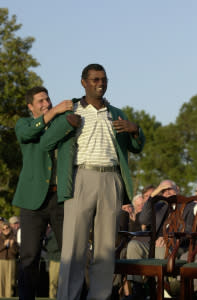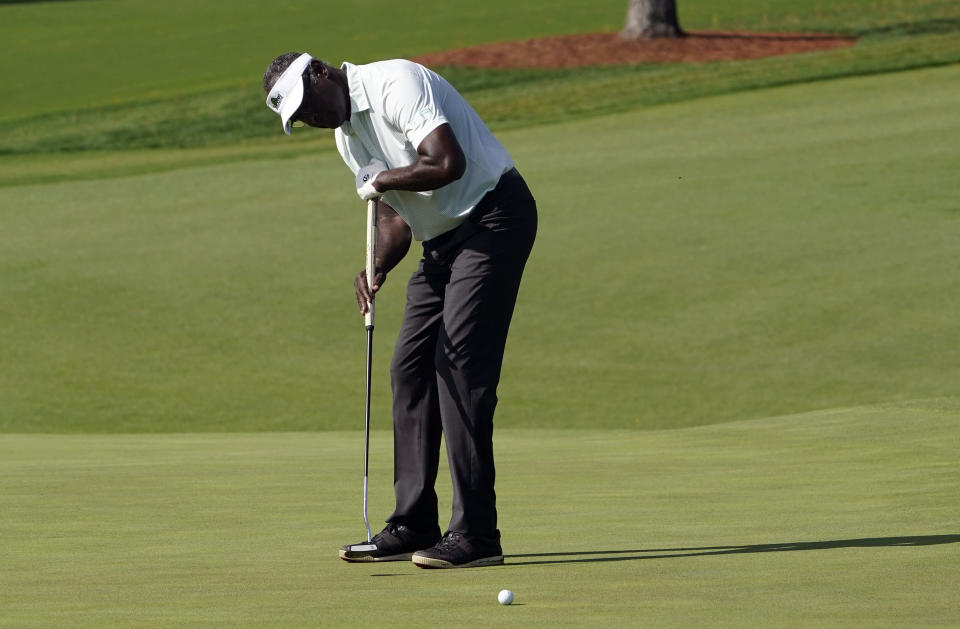Vijay Singh dishes on infrared saunas, swinging a sledge hammer and his intense workouts

World Golf Hall of Fame member Vijay Singh’s exercise routine includes swinging a sledge hammer at an oversized tire, tossing a regular-sized tire at his trainer and throwing a medicine ball around like it’s a bean bag. His workout video, which has been viewed nearly 10,000 times on YouTube, ought to have been set to “Gonna Fly Now,” the “Rocky” theme song, as his unconventional Balboa-esque training regimen stops just short of hitting a side of beef and chasing a chicken.
Singh’s work ethic always has been second to none, and those workouts have helped him win 22 times after age 40 and four more titles on the PGA Tour Champions since turning 50. But as the 57-year-old Fijian begins to creep up there in age, he’s found the need to go next-level with his workout routine to stay relevant on the PGA Tour and PGA Tour Champions. Singh, who counts three majors among his 34 PGA Tour titles, spoke to Golfweek this year about his pursuit of speed and never-ending quest to get better.
GW: You’ve always possessed a long and fluid swing. What are you doing to remain limber?
VS: When you get older, your backswing gets shorter and your muscles and joints get stiffer. I’m trying to lengthen my backswing while maintaining a long rhythm as well, and trying to be aggressive through the ball.
That means a lot of stretching and band stretching. Weights. I’m swinging a heavy club to make sure I’m swinging long. I’ve been fortunate to be limber all my life. It was never a big deal to be long, but if you’re not working on it, you get shorter. With the injuries I had last year (a back injury forced him to withdraw from the 2019 PGA Championship), I didn’t work on that stuff. The weighted club is really important to get power.
GW: Can you point to a specific time when you started to have to work at it?
VS: Last year. As you get older you don’t feel as strong. I went to another gear, doing a lot more strengthening work, a lot more fast-twitch work, medicine ball and bands and explosive work. If you do that, it’s not such a struggle to hit it long. Medicine ball and bands have been key for me.
Even lifting weight isn’t so much about how heavy you can lift it but how fast you can move the weights. If you’re doing chest presses, it has to be a fast, explosive outward motion. If you’re doing throws, it’s a fast, inward motion. If you’re doing bicep or tricep, it’s a fast, contracting motion. A lot of rotation band work.
GW: You gained notoriety for your Rocky Balboa-esque workout routine. How did you get started doing such an unconventional and intense workout?
VS: We’ve been doing it for a while. It’s a hard workout. This morning we did it for an hour. Every other day, Monday, Wednesday and Friday, we do a different outside workout and then we come inside and lift weights. I spend four hours on the golf course and come back and do infrared sauna. You do that for 30-45 minutes and you feel like you’ve run a marathon. It’s really good for the body and recovery. I’ve had it for about a year.

Vijay Singh is presented with the green jacket by Jose Maria Olazabal after winning the 2000 Masters Tournament. (Chris Smith/Getty Images)
GW: According to your former caddie Paul Tesori, the most genius swing advice you’ve come up with is “Complete, Bump, and Fire.” What does that mean?
VS: Tesori told you about that? (Laughs) Completing is your back swing. Like a baseball pitcher throwing a ball, he really loads up. Bumping is make sure you get to your left side, that nudge to the left side, almost like a sit-down position, you might call it. Everything is moving to the left side of the body and the weight is shifting left. Fire is you hit the ball with a snap of the left leg, fire the hips and hit through the ball.
GW: Do you think of clearing the hips as the key?
VS: It’s one part of it. It’s a very important part of the golf swing. It used to be a natural thing. Everyone would say take it back and rotate your hips. Ten years ago, it became a trend to stop moving your hips as much, try to be as tight as possible. That created a lot of injuries. If you try to stop anything from moving, you are going to create tension, and that creates stiff muscles and you get injuries.
I think let the hips move the way they are supposed to and not restrict it, and coming down you let it happen and at impact you really snap your hips as much as possible. You see it in the longest hitters, and the only way to do that is turn the hips when you’re going back as well.
Ernie
Fred
VijayThat's 68 @PGATOUR wins on the range at @BridgestoneSP. pic.twitter.com/9O5slvYPjm
— PGA TOUR Champions (@ChampionsTour) August 13, 2020
GW: I often would see you put a stick or shaft in the ground and work on clearing the hips. Is that a drill you still do?
VS: It’s all about rotation. You’ve got to bump your hips to the left side and not rotating your hips through the impact area, then it’s just going to be a slide through without any power in it. Putting the stick on the ground had a lot of meanings for me. One was to do with my plane. If you put a stick or bottle in front, it stops you from thinking about what you need to do and lets the swing adjust to that.
GW: I also have seen you use a Gatorade bottle to the right of the ball. What’s the purpose of that drill?
VS: I do from time to time, did so the other day. Sometimes I use the plastic divot fillers. It promotes a swing exiting left through the hitting area and promotes a fade. That way I don’t get under the ball.
GW: How do these drills help you to eliminate the left side of the golf course?
VS: That was always my goal, and I got there to a point. It’s all in my head. My whole thought has been a left-to-right shot. I’m aiming left so I don’t want to miss left. You have to be very aggressive with your left side. Your left side has to be really strong from the ground up and be left-side oriented. I’m very left-sided. When I’m coming down to hit the ball, I really have to focus on pulling really hard with the left hand.
That used to be second nature for me. When you start to lose your distance and try to engage more power, what happens? If you’re a right-handed golfer, your right side is stronger than your left and that’s what started to happen to me. When I was in my prime, I was really focused and everything was left-handed.

Vijay Singh follows his shot from the fifth tee of the Pebble Beach Golf Links during the final round of the 2004 AT&T Pebble Beach National Pro-Am.
GW: You are a renowned range rat. But your former caddie Paul Tesori says you never waste a ball. What’s your routine like these days?
VS: Hitting balls for four hours is pretty hard now. I putt for a bit, chip for a bit, hit some short wedges and then work on my backswing. I don’t change very much of what I work on. It may be a different version of it, but mostly the same thing.
On the putting green, I start with long putts to feel the motion. We all go on the putting green and work on the putting stroke, and I’m trying to get away from being too mechanical. It’s hard to do. If you go on the putting green on a Monday or Tuesday at a Tour event, everyone is working on something.
I try to feel free as much as possible. I’m trying to feel like I’m taking it back and through to the target that I aim. It’s not easy. Putting has never been the strong suit of my game, but I enjoy it. If my back was better, I’d practice a lot longer.

Vijay Singh putts on the second green during the first round of the Masters at Augusta National GC. (Michael Madrid-USA TODAY Sports)
GW: What are your favorite training aids for putting?
VS: I’ve pretty much used them all trying to improve. To tell you the truth, I think they’ve done more harm than good.
The easiest thing to do is try to roll the ball over a specific target. I have a ruler and I try to keep the ball rolling 3 yards down the ruler. If I can do that, then it means I’m hitting my lines. I’ll spend 10, 15, 20 minutes doing this drill. But I take the ruler everywhere I go when I travel, so if I feel like I’m struggling with my putting I’ll use it back in my room.
GW: Is there a particular part of your game you’re spending more time on?
VS: Middle to long irons is what I’m working on. I should be working on the shorter irons more for the Champions Tour. I’m more focused on playing there these days.
GW: What’s the one thing you want to tell our readers to think about in the golf swing?
VS: Think about rhythm more than anything. If you’re quick, you’ll never complete your backswing. I think a lot of people forget that.
The timing of the golf swing is way more important than going out and hitting a million balls. If you can swing with a good rhythm, the golf swing is going to be a lot better. A guy shoots 62 one day and then 73 the next day, he hasn’t changed his golf swing. He’s changed his timing.
Everyone who is out there and is going to read this should know that the timing of the backswing should be a lot slower than it used to be. In my prime, I’d think to myself, 1-2, or sometimes the number 17. You can’t rush “17.” You can rush “one.” Just feel the rhythm.

